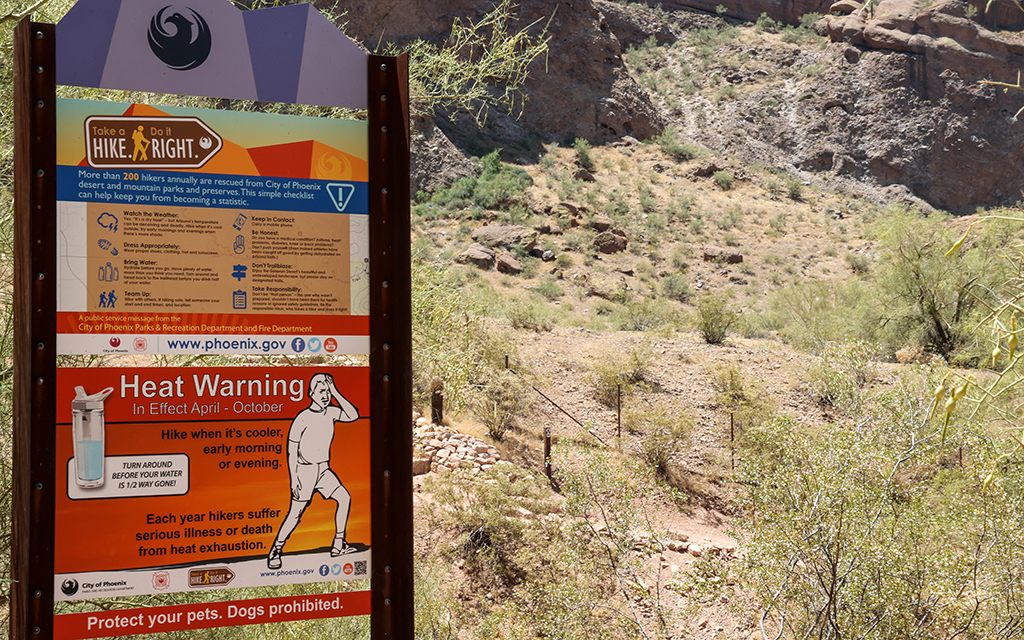
With temperatures expected near 115 – again – this weekend, Phoenix could be in the national spotlight. But a new Census report that looks at income, housing, household and other data to determine community resilience to disasters says residents of other states, and other parts of Arizona, may have more risk factors related to heat. (Photo by Airman 1st Class Erick Requadt/U.S. Air Force)
WASHINGTON – Headlines across the country will likely focus this weekend on Phoenix, where temperatures could reach 115 degrees, but a new report says the greater heat threat may be in counties hugging the state’s borders – and even in other states.
An analysis of factors that the Census Bureau says contribute to a community’s social vulnerability to disasters shows 13 states and the District of Columbia have more risk factors for heat-related harm per person than Arizona.
Within the state, the report by Census Bureau and Arizona State University researchers said the most risk factors were found in Santa Cruz County on the southern border, Gila County, Apache and Navajo counties in the northeast and Yuma, La Paz and Mohave counties on the western border.
The report relies on a new interpretation of the Census Bureau’s Community Resilience Estimates, which measure everything from income to housing to predict vulnerability to disasters including pandemics, hurricanes – and now heat.
Chase Sawyer, a Census Bureau analyst who co-authored the report, said while it’s not surprising to see Arizona lower on the list than other states, it would rank higher if the report measured exposure and temperature.
“We’re only really measuring people and the households they live in,” Sawyer said Friday. “We don’t have it worked in yet, on that exposure to heat or how likely it is that a heat event is going to occur, and so that is actually one of the major points that we want to continue to refine and make better.”
The Community Resilience Estimate used for the heat report was developed during the pandemic to measure effects of COVID-19 on communities, and has since been expanded to apply to other disasters, natural and human-caused.
The original CRE considered 10 factors, including income, employment, access to health care, household size and communication barriers, among other elements. The CRE for Heat looked at the same factors, but it modified those that consider housing quality, commute type and whether household costs exceed 50% of income.
That produced a nationwide, county-by-county breakdown of heat-related vulnerable communities.
Patricia Solís is executive director at ASU’s Knowledge Exchange for Resilience, which assisted the Census with the report. She said the report aims to identify areas that are least-resilient to heat so that aid may be distributed more effectively.
Solís said economically distressed areas, which are often rural, for example, have a harder time keeping cool. She said people without air conditioning – or the funds to use it – are a very vulnerable population in a heat wave.
(Graphic by Erin Murphy/Cronkite News)
“The first thing that you need in any disaster is shelter, right?” Solís said. “But in the heat context, what do you do? You go home and turn on the AC – if you can do that.”
Apache County has the state’s highest share of residents with three or more risk factors, with 55%, more than twice the rate of high-risk residents in Maricopa County.
Emergency management officials in Apache County – and most other high-risk counties in the state – did not immediately respond to requests for comment. But an official in Santa Cruz County, where just under 33% of the residents have three or more risk factors, said the county is doing just fine in terms of heat-related emergency management.
Sobeira Castro, director of the county’s emergency management, said they are “well equipped to deal with extreme heat.” She believes only certain individuals in the county, including migrants crossing the border and some retirees, are particularly at risk.
“A lot of the people that come and live here are retired individuals that have retired from previous jobs in California and other places on the East Coast,” Castro said. “They come and they retire here and they’re not used to the weather.”
Castro said she is confident that there are “enough resources available within the county” to help the community, but she worries about thunderstorms that might lead to power outages heading into the abnormally hot weekend.
“If the electricity goes out then they have no air conditioning,” she said. “We are making sure that everything is backed up, all the generators.”
(Graphic by Lauren Irwin/Cronkite News)
In Maricopa County – which has added respite locations across the Valley in addition to cooling and hydration stations – preparations for extreme heat this year are particularly focused on the homeless population, said Cleo Warner, a human services planned at the Maricopa Association of Governments.
“Especially for our unsheltered population, where sleep is very hard to come by – and oftentimes people are sleeping during the day – when it is 110 degrees, sleeping outside becomes an incredibly dangerous activity,” Warner said.
Warner said Maricopa County’s heat-relief efforts are driven largely on volunteers. She believes rural counties are trying to follow suit – but they face challenges that urban areas do not have.
“Just from conversations with these more rural communities that are trying to figure out how to start up a Heat Relief Network of their own,” she said, “it’s my understanding that there are very different barriers for them, particularly like how spaced out everything is and just in general, lower frequency of resources.”
Solís said the concern of surviving a heat wave in Arizona is what pushed her to connect with the Census Bureau in the first place. The CRE for Heat report, she said, produces findings that can be used to spark action.
“On a national scale, there’s a lot of talk about this … because heat is affecting not just Arizona but other places,” Solís said of the heat wave gripping much of the nation this week.
Unlike hurricanes or blizzards, however, Solís said heat is not recognized as a hazard by the Federal Emergency Management Agency. That means states cannot receive disaster funding for heat, even though in Arizona it “is responsible for more deaths than the other weather-related deaths combined.”
In 2022, 425 people died due to heat-related complications in Maricopa County alone.
“You look outside and it looks like a nice sunny day,” Solís said. “It doesn’t look like a disaster and it doesn’t operate in the same way, it’s silent, it’s invisible.”
While Sawyer said Census wants to expand on its CRE reporting, Solís hopes that on a state level, Arizona can focus on housing and heat challenges. Challenges that she said go hand-in-hand.
“When we don’t have this big threat of a heat wave down on us right at this moment, we need to stop and remember and take time to work on those upstream solutions,” Solís said.




